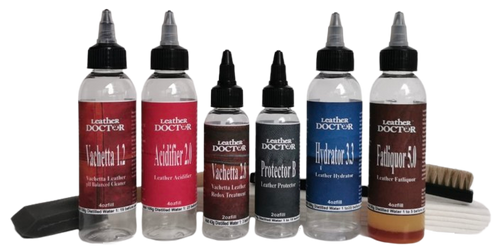![]() Vachetta Leather Browning Remover and Care Kit V3 by Leather Doctor deep cleans, pH balances, hydrates, softens, removes unsightly browning, and protects its natural beauty.
Vachetta Leather Browning Remover and Care Kit V3 by Leather Doctor deep cleans, pH balances, hydrates, softens, removes unsightly browning, and protects its natural beauty.
![]() Experience the Science of Leather care!
Experience the Science of Leather care!
With the right treatment systems, Vachetta can be revived, protected, and maintained to gracefully age—just as it was meant to.
What is Vachetta or Vegetable-Tanned Leather?
Vachetta—also known as vegetable-tanned (veg tan) leather—is a natural, unfinished leather tanned using plant-based tannins. It has a distinctive pale, biscuit color, untouched by dyes or pigments. This leather is left naked—without synthetic topcoats—making it both beautiful and delicate. It’s famously used in Louis Vuitton handles and trims, prized for the unique patina it develops over time.
Why Does Vachetta Suntan?
Like fair skin, Vachetta darkens when exposed to sunlight. Unlike other leathers dyed with aniline or pigments, Vachetta doesn’t fade—it tans. While this is part of its charm, overexposure can lead to uneven darkening. To lighten these sun-tanned areas, a Redox (oxidation-reduction) reaction is used to gently reverse the discoloration.
Why Does Vachetta Develop Browning Discoloration?
Vachetta is highly pH sensitive. Even something as mild as tap water (pH 7) can cause discoloration or visible rings. High-pH products like baking soda, saddle soap, and some commercial cleaners are a recipe for browning and damage. These browning stains happen when alkaline substances destabilize the natural tannins in the leather, leading to unsightly dark marks.
How to Correct Browning on Vachetta Leather
Restoring browned Vachetta requires two key stages:
1️⃣ Pre-Cleaning & pH Balancing
- Gently cleans the leather.
- Restores its natural pH range (3–5).
- Prepares the structure for conditioning.
2️⃣ Post-Treatment with Redox Reaction
- Performed after fatliquoring.
- Reverses browning through oxidation-reduction.
- Lightens dark spots caused by pH damage or sun exposure.
Why is Fatliquoring Essential for Vachetta?
Fatliquoring replenishes vital fats and oils lost over time. Without them, Vachetta leather dries out, stiffens, and cracks due to Van der Waals forces, where fibers stick together and become brittle.
- Fatliquor softens, strengthens, and restores flexibility.
- Up to 15% fat and oil content is ideal for healthy leather.
- It must be applied while the leather is still damp to ensure deep penetration.
Preventing Cracks & Controlling Absorbency
- Aged or dried-out Vachetta should be conditioned before any Redox treatment.
- Fatliquoring fills the microscopic voids, reducing absorbency and preventing further stains.
- Natural, slow drying keeps the leather supple and prevents shrinkage.
![]() Managing Vachetta Appearance During Restoration
Managing Vachetta Appearance During Restoration
- Always feather out cleaning and treatment to the edges of the panel.
- Achieving even saturation means achieving an even final appearance.
- For mild discoloration, low pH cleaners (around 1.2) and a rinse (pH 2.0) may be enough.
- For deeper browning discoloration or alkaline stains, follow up with Redox treatment.
Protecting Vachetta from Scuffing & Wear
Because it's unfinished, Vachetta is prone to surface scuffs.
- Conditioning with fatliquor improves resistance.
- A non-stick, rub-resistant surface protector helps reduce scuff marks.
- This protection maintains the leather’s natural texture and breathability.
- Eraser 4 helps lighten up appearance when dry.
![]() How Fatliquoring Works
How Fatliquoring Works
Fatliquoring involves two steps:
1️⃣ Hydration to open the leather fibers.
2️⃣ Fatliquor application, where:
- 5/6 of the solution evaporates.
- 1/6 (the fats and oils) stays behind to lubricate the leather internally.
- Fats plump the leather.
- Oils act as lubricants so fibers can move and bend freely.
Once dry, a hydrator is used to clean up any residues, completing the treatment.
Eraser 4 removes surface residue to lighten up the leather.
Easy-to-Use Concentrate
Kit V3 concentrates contents require 519g (0.6quart) 4ozfill and 1036g (1.14 quarts) 8ozfill distilled water to be mixed and filled before use with these selected leather-safe products:
Kit V3 Product Summary Includes:
✅ Vachetta 1.2 - 4ozfill / 8ozfill
✅ Acidifier 2.0 - 4ozfill / 8ozfill
✅ Hydrator 3.3 - 4ozfill / 8ozfill
✅ Fatliquor 5.0 - 4ozfill / 8ozfill
✅ Vachetta 2.8 - 2ozfill / 4ozfill
✅ Protector B - 2ozfill / 4ozfill
✅ Brush 1 - 1pc / 1pc
✅ Foam 2 - 1pc / 1pc
✅ Towel 5 - 5pc / 5pc
![]() Instruction:
Instruction:
1️⃣ How to Work with Vachetta 1.2 and Acidifier 2.0 systems?
- Vachetta 1.2 is applied and worked with a lint-free folding towel with detail brushing accordingly and feathering out to the edge of the panel changing folding sides as soiling shows.
- Even product absorption is observed for a desired appearance when dry.
- Acidifier 2.0 is applied and worked accordingly as above with towel extraction until the new folding sides show clean again with an even appearance before hydrating.
2️⃣ How to Work with Hydrator 3.3 and Fatliquor 5.0 systems?
- Hydrator 3.3 is applied and worked by towel padding or brushing accordingly with towel extraction until new folding sides show clean.
- Hydrator 3.3 is again applied to plump with massaging, staking, flexing or stretching, and towel extraction until the new folding sides are dry.
- Fatliquor 5.0 is applied, towel padded, and brushed into the leather to plump softness and let it dry.
- Fatliquor 5.0 is repeatedly applied each cycle the water content dries until the last application when the leather absorbs no more ends the repeat application, and the leather is left for slow drying.
- Fatliquor 5.0 remnant if any is driven into the leather or wiped off with Hydrator 3.3 and left to dry before redox treatment.
3️⃣ How to work with Vachetta 2.8
- Vachetta 2.8 is applied over the dried surface and towel padded saturating evenly without a dry edge to avoid blotchiness or drying marks and left to dry for an oxidation-reduction reaction to take effect.
- The appearance is inspected during treatment or after drying and may be repeated accordingly.
- After dry inspection, any surface residue is wiped away with Hydrator 3.3 and let to dry again for a satisfactory inspection, otherwise repeat.
4️⃣ How to work with Protector B?
- Protector B is applied and spread out with a lint-free towel let dry and the leather is ready to use.
![]() Your opinions, insights and review are precious and will help us to solve your leather problem more efficiently.
Your opinions, insights and review are precious and will help us to solve your leather problem more efficiently.
Updated: Aug 19, 2024 | April 10 2025|May 13, 2025 | July 16, 2025 | August 1, 2025 | August 18, 2025 | September 20, 2025 | October 27, 2025 by Roger Koh.
![]() How to Identify Leather Stains?
How to Identify Leather Stains?
![]() How to Use this Vachetta Leather Problem-Solving Matrix?
How to Use this Vachetta Leather Problem-Solving Matrix?
Vachetta Leather pH Balanced Cleaner 1.2
Vachetta 1.2 by Leather Doctor® is a Specialty Cleaner for Veg-Tan & Vachetta Leathers to remove the common blotchy browning water stains.
It is a low-pH (1.2) specialty cleaner formulated to balance pH, clean, rectify, and restore vegetable-tanned leathers—especially Vachetta. It is uniquely designed to address common blotchy browning stains caused by sweat, watermarks, and alkaline cleaning products, which are particularly problematic on naked, unfinished leathers.
It works by gently emulsifying general soiling through penetration, lubrication, and suspension, allowing the contaminants to be extracted with a clean towel. It restores leather to a more uniform appearance without harshness.
For deeply penetrated body oil and grease stains, use Degreaser 2.2 first, followed by a towel extraction. Vachetta 1.2 should then be applied to continue cleaning over the degreased area and extend evenly across the panel—ensuring no dry edges.
Holistic Leather Softening System (to Prevent Cracking) To prevent leather from drying and cracking after cleaning:
- Clean with Vachetta 1.2
- Rinse with Acidifier 2.0
- Hydrate with Hydrator 3.3
- Fat and Oil Replenishing with Fatliquor 5.0
Important:
- Maintain a minimum 25% moisture level between each step.
- Allow complete drying only after Fatliquor 5.0 is absorbed.
- Dry fatliquor content should be at 14%—use a leather moisture meter to verify, or until it absorb no more.
- Drying prematurely without enough fat and oil content increases the risk of cracks.
To brighten and correct sun-tanning effects, follow with Vachetta 2.8 Redox. This oxidation-reduction treatment further lightens and evens out color.
Acidifier 2.0 by Leather Doctor® is a pH 2.0 acidic rinse designed to control, neutralize, and restore leather’s natural pH balance.
It prevents leather from denaturing, which can lead to bleeding, streaking, tackiness, and structural weakness due to alkaline overexposure.
Hydrator 3.3 by Leather Doctor® is a pH 3.3 hydrating conditioner designed to relax, soften, and restore leather’s natural integrity while preparing it for fatliquoring.
Key Benefits:
- Restores Leather Softness & Flexibility – Relaxes stiff fibers and prevents brittleness
- Smooths Out Creases & Wrinkles – Prepares leather for optimal conditioning
- Reactivates Dormant Dyestuff – Helps resurface color for a more even appearance
- Prepares for Fatliquoring – Enhances absorption of essential oils and fats
- Residue-Free & Non-Sticky – Ensures a clean, breathable finish
How It Works:
- Hydrator 3.3 penetrates deep into the leather, reducing surface tension and allowing for colloidal water movement to reactivate tannin and even out color inconsistencies. It plumps the leather structure, making it more receptive to fatliquoring with Fatliquor 5.0, which restores essential fats and oils for long-term suppleness and durability.
- Hydrator 3.3 is an essential step in rejuvenating aged, dry, or stiff leather, ensuring lasting flexibility, color vibrancy, and overall leather health.
Fatliquor 5.0 by Leather Doctor® is a pH 5.0 micro-emulsion of fat, oil, and water to restore the leather's original softness, strength, and flexibility.
How It Works:
- Replenishes Essential Fats & Oils – Prevents leather from drying, stiffening, or cracking
- Enhances Leather’s Suppleness & Elasticity – Maintains a soft, luxurious feel
- Strengthens Leather Fibers – Improves tensile strength and durability
- Creates a Breathable Structure – Ensures leather remains pliable without feeling greasy
- Prevents Brittleness & Fiber Breakage – Essential for long-term leather preservation
Application Process:
- When applied, the water-encased fat and oil molecules penetrate deep into the leather fibers. As the water gradually evaporates, the fat and oil molecules hydrogen bond with the fibers, creating a breathable, flexible structure that enhances leather’s resilience and longevity.
- Proper fatliquoring ensures that leather retains its tensile strength, resists breakage, and maintains its natural softness, preventing premature aging and deterioration.
Vachetta Leather Redox Treatment 2.8
Vachetta 2.8 by Leather Doctor® is an oxidation-reduction reactor for lightening, browning, suntanning, and water discoloration. Browning in Vachetta requires an oxidation-reduction (Redox) reaction treatment. This should only be performed when the leather is dry.
In leather restoration, a redox system or process is used to reverse oxidation damage or lighten darkened/discolored areas of leather without harming the material.
Over time, leather darkens due to:
- Oxidation of fats/oils (from skin contact or conditioners),
- Exposure to UV light,
- Environmental pollutants,
A redox system uses both oxidation and reduction reactions to safely bleach out unwanted discoloration, remove stains, or reverse darkening.
Example: Leather Doctor® Lightening Process
Let’s say a vegetable-tanned leather bag has oxidized and turned dark due to age and skin oils:
- Degreaser 2.2: To remove oxidized oils.
- Acidifier 2.0 & Hydrator 3.3: Rebalances the pH and hydrates the collagen fibers.
- Fatliquor 5.0: Reintroduces healthy fats and oils, and restores suppleness.
- Vachetta 2.8: A specialty product designed to break down organic discoloration (oxidation stage).
This sequence acts like a controlled redox reactor—done by hand, but with precise chemistry and order.
Always follow up with surface conditioning to keep leather healthy.














